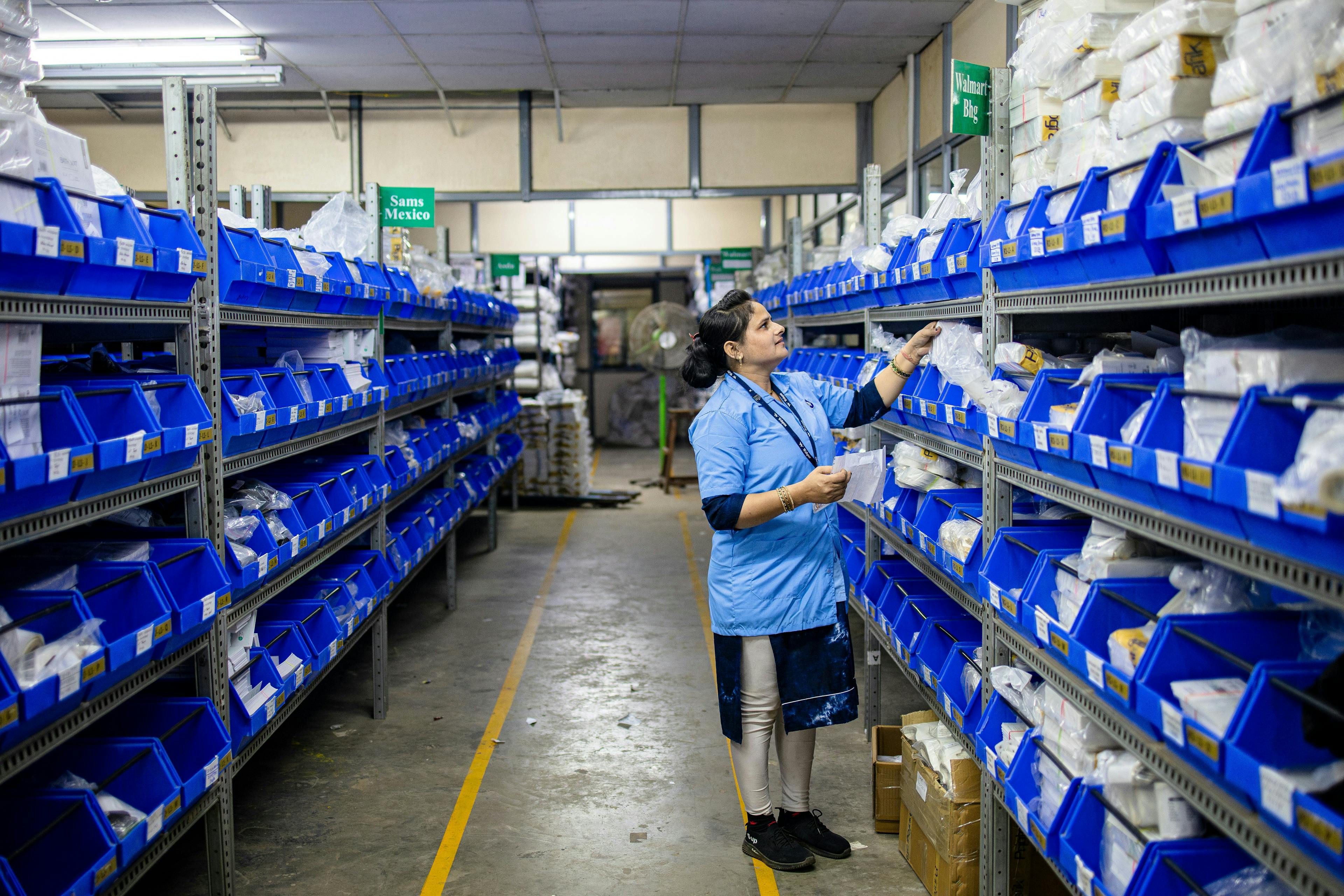Mastering Productivity Calculation: Formulas & Examples


Imagine managing a workforce spread across multiple locations, with different shifts and varying productivity levels. How do you know which teams are performing well and which need support? Companies that actively measure workforce productivity see better operational efficiency and profitability, yet productivity calculation remains one of the most challenging aspects of modern business management. Despite its direct impact on bottom-line results, most organizations can't figure out which metrics to track, how to collect accurate data, or how to turn measurements into real improvements.
The challenge gets trickier across different work settings. Manufacturing needs a different approach than field teams. Warehouse operations need distinct metrics from office work. Most companies either make things too simple and miss key insights, or make things too complex and create analysis paralysis.
This framework will help you calculate and improve workforce productivity across any operation. You'll discover six proven calculation methods, learn exactly when to use each one, and gain tools to turn productivity data into real business results. Whether you're tracking output per hour or complex multifactor productivity, you'll have a clear path forward.
Step-by-Step Workflow to Measure Productivity
The bottom line: Productivity measurement boils down to one simple equation: Productivity = Output ÷ Input. This formula gives you instant insights into how efficiently your team converts resources into results, no complex spreadsheets needed.
Here’s a clear six-step process that turns raw data into actionable insights. Without this structure, you risk collecting useless data, misinterpreting results, or creating metrics that don't drive real improvement. This systematic workflow works across industries, from manufacturing to service teams, though specific metrics vary based on your operation.
Step 1: Define Success (Output & Quality)
Begin by clearly identifying what counts as valuable output for your team. In manufacturing, this might be defect-free units produced per shift. For customer service, it could be cases resolved with high satisfaction scores. Balance quantity with quality—measuring output without considering quality can produce impressive numbers that hide declining performance. Document both output measures and quality thresholds before moving forward.
Step 2: Select the Right Input(s)
Start by identifying which resources you'll measure against your output. Labor hours are most common, but you might also track materials, equipment usage, or energy consumption depending on your operation. Your choice of inputs significantly affects your final productivity calculation. A call center might focus purely on agent hours, while a manufacturing plant needs to account for labor, materials, and machine time.
Step 3: Choose an Appropriate Calculation Method
Select the productivity formula that fits your data availability and business goals. Simple output-per-input ratios work well for straightforward operations, while multifactor approaches better capture complex processes involving multiple resource types. Start simple and add complexity as your measurement capabilities grow.
Step 4: Gather Clean Data
Focus on collecting accurate, consistent data from reliable sources like time-tracking systems, ERP exports, or safety logs tied to established safety operating procedures. This step often presents the biggest challenges, especially for dispersed teams or operations with limited digital tools. Clean data collection requires clear protocols for when and how data gets recorded, ensuring consistency across shifts, locations, and time periods.
Step 5: Run the Calculation
Apply your chosen formula to the collected data, ensuring unit consistency throughout. Double-check your math and verify that results make sense. If your productivity calculation shows dramatic changes without corresponding operational changes, check for data quality issues before proceeding.
Step 6: Benchmark, Interpret, and Communicate Results
Compare your results against internal historical performance, industry standards, or peer organizations. Effective benchmarking helps put your numbers in context and identify improvement opportunities. Communicate findings clearly to stakeholders—ideally through an employee notification system that pushes real-time updates—focusing on actionable insights rather than raw numbers.
Different industries apply this workflow with varying emphasis. Manufacturing typically invests heavily in Steps 4 and 5, using sophisticated data collection systems and complex calculations. Service industries often spend more time on Step 1, carefully defining output quality measures that capture customer value. Retail operations might focus on Step 6, using benchmarking to drive competitive performance improvements.
Be ready to adjust your approach. If your productivity metrics don't align with business outcomes, revisit your output definitions in Step 1. If data collection proves too burdensome, simplify your approach in Steps 2 and 3. Regular review ensures your measurement system evolves with your business needs.
Deep Dive: 6 Proven Methods to Calculate Productivity
Understanding productivity through various formulas lets businesses tailor approaches based on their industry needs, data complexity, and specific goals. These methods provide structured insights into efficiency, enabling better decision-making.
1. Standard (Single-Factor) Productivity
The simplest productivity formula provides immediate insights into operational efficiency. Standard Productivity is calculated as:
Productivity = Output ÷ Single Input
Example: If a factory produces 1,000 units using 200 labor hours:
Productivity = 1,000 ÷ 200 = 5 units/hour
This method shines through its simplicity and works well across manufacturing and warehousing environments. But it misses other contributing factors, potentially giving skewed insights if significant inputs like capital are ignored.
2. Labor Productivity
When labor costs drive your operation, this focused approach reveals team efficiency. Labor productivity is calculated as:
Labor Productivity = Output ÷ Labor Hours
Example: If a warehouse ships 450 packages using 30 labor hours:
Labor Productivity = 450 ÷ 30 = 15 packages/hour
This approach works best when labor is the primary productivity driver. It does overlook the role of other resources like technology or equipment.
3. Multifactor Productivity (MFP)
For complex operations, a single input measure isn't enough. MFP expands the analysis by considering multiple inputs like labor and capital.
MFP = Output ÷ (Weighted Labor + Weighted Capital + Other Inputs)
Example: Suppose a company produces $500,000 worth of goods using:
- $100,000 in labor (weight = 0.6)
- $50,000 in capital (weight = 0.4)
MFP = 500,000 ÷ [(0.6 × 100,000) + (0.4 × 50,000)] = 500,000 ÷ (60,000 + 20,000) = 500,000 ÷ 80,000 = 6.25
This formula works well in industries requiring a holistic approach, though gathering precise input data can be challenging.
4. Total Factor Productivity (TFP)
For tracking long-term efficiency gains across your entire operation, TFP provides broader perspective.
TFP Index = Index of Real Output ÷ Index of Combined Inputs
Example:
If the output index increases to 115 and the input index is 100:
TFP = 115 ÷ 100 = 1.15 (or a 15% gain in productivity)
This method is typically used in macroeconomic and industry-wide analyses.
5. Percentage of Goal Met
This goal-oriented method aligns productivity with performance targets. It's calculated as:
% of Goal Met = (Actual Output ÷ Target Output) × 100
Example: A sales team has a target of 120 units and achieves 108 units:
% of Goal Met = (108 ÷ 120) × 100 = 0.9 × 100 = 90%
It’s best used when there’s a clear, predefined target and the aim is to track performance progress.
6. Software-Based Productivity Metrics
Modern productivity tracking often relies on software tools. These can include:
- Time tracking per task or project
- Automated output counts (e.g., tickets closed, calls made)
- Communication analytics (e.g., response times, resolution rates)
While there isn’t one universal formula here, platforms may use internal metrics like:
Productivity Score = (Tasks Completed ÷ Time Logged) × Quality Score
These metrics are customizable but should be aligned with operational goals and employee privacy considerations.
Setting Benchmarks, Targets & Quality Controls
First establish what "good" looks like for your operation before pursuing improvement. Start with your own historical data, then look outward to industry standards. Internal benchmarks track your improvement over time using past performance as the baseline. External benchmarks show whether you're competitive within your sector by comparing against industry averages or top performers. Internal benchmarking reveals trends and seasonal patterns, while external benchmarking tells you if your productivity levels can compete in the market. To validate sentiment and quality metrics, consider anonymous pulse surveys and varied survey distribution methods that reach both desk and non-desk employees.
Your industry context determines which benchmarks actually matter. A warehouse team picking orders has completely different productivity standards than a customer service team handling calls. Seasonal businesses must account for peak and off-peak periods when setting targets. Manufacturing teams might track units per hour, while service teams focus on resolution times or customer satisfaction scores. These contextual differences mean your benchmarks must reflect realistic, achievable targets that make sense for your specific operation.
Volume without quality destroys real productivity gains. Hitting 100% of your production target means nothing if your defect rate doubles or customer complaints surge. A team producing 200 widgets per hour with a 15% defect rate performs worse than one producing 180 widgets with a 2% defect rate. Quality metrics like error rates and customer satisfaction should carry equal weight with output measurements in your productivity calculations.
Multi-site operations need systematic approaches to fair benchmarking. First, normalize data across sites by accounting for equipment differences, workforce experience levels, and local operating conditions. A brand-new facility can't immediately match a 10-year veteran location's performance. Second, set tiered targets based on site maturity rather than applying universal standards across all locations. Third, refresh benchmarks quarterly to account for process improvements, seasonal variations, and changing business conditions.
Clear communication builds team buy-in for your productivity initiatives. Share the reasoning behind your numbers, not just the targets themselves. Explain how benchmarks connect to business objectives and customer outcomes. Transparent communication about performance expectations helps teams understand their role in broader organizational success and reduces resistance to measurement programs.
Turning Numbers into Action: Improving Workforce Output
Meaningful productivity improvement starts with turning data into practical actions that drive results. Once you've calculated your productivity metrics and established benchmarks, the real work begins. Transforming those numbers into meaningful improvements requires a systematic approach that addresses both the technical and human sides of productivity enhancement.
Your improvement journey should follow a proven four-step cycle that turns data into results. Start by identifying specific gaps between your current performance and established benchmarks. This goes beyond spotting low numbers—look for patterns that reveal underlying issues. If your warehouse shows 20% lower picking rates on night shifts compared to day shifts, you've found a concrete gap to address.
Next, diagnose the root causes behind these gaps. Poor productivity often stems from skills gaps, inadequate tools, or inefficient processes rather than employee motivation. Your night shift might struggle because of insufficient lighting, different inventory layouts, or lack of experienced supervisors. Observe workflows, interview team members, and analyze your data from multiple angles.
The third step involves implementing targeted changes based on your diagnosis. This might include up-skilling programs, process automation, enhanced safety training, or improved communication systems. Successful productivity improvements often combine multiple interventions—upgrading equipment while providing training typically yields better results than either action alone. For dispersed teams, communication improvements can be particularly impactful, especially when using SMS tools that reach every team member instantly.
Finally, re-measure and iterate based on your results. Productivity improvement is an ongoing cycle, not a one-time fix. Monitor your metrics for at least three months to ensure changes stick and continue delivering value.
When prioritizing improvement initiatives, focus on changes that offer the highest return on investment. Address safety issues first—they often provide immediate productivity gains while protecting your workforce. Next, tackle bottlenecks that affect multiple teams or processes. A communication system upgrade might seem expensive initially, but it typically pays for itself through reduced downtime and faster issue resolution.
Change management drives successful implementation. Engage employees in the improvement process from the beginning, explaining how changes will benefit both the organization and their daily work experience. Address resistance by providing clear training, ongoing support, and transparent communication about results. When teams see their efforts reflected in improved metrics and recognition, resistance typically transforms into enthusiasm for continuous improvement.
Special Considerations for Dispersed & Non-Desk Teams
Traditional productivity tracking falls apart when your team isn't sitting at desks or working in a single location. Managing teams scattered across multiple locations, shifts, or job sites breaks traditional productivity tracking methods. Field workers, warehouse staff, and remote crews face unique challenges that make standard measurement approaches ineffective or impossible to implement.
The primary hurdles include patchy data capture due to inconsistent internet access, limited device availability since many workers rely on personal phones, and multilingual crews who may struggle with complex tracking systems. Multi-site operations require specialized approaches that account for these realities while still delivering actionable productivity insights.
SMS-based solutions like Yourco often outperform traditional employee communication apps by using the one communication channel that works reliably across all devices and locations. You can collect real-time productivity data through instant polls asking workers to confirm shift completion, report output numbers, or flag issues. Shift confirmations become automatic check-ins that verify attendance and readiness, while multilingual templates ensure every team member understands requests regardless of their primary language.
Consider this SMS productivity tracking workflow: Start each shift by texting workers a brief check-in request. Mid-shift, send a quick poll asking for current output or status updates. End the shift with a completion confirmation that captures total units processed or tasks finished. These responses automatically feed into your productivity calculations without requiring apps, logins, or complex interfaces.
Your rollout checklist should include setting up proper opt-in processes to comply with messaging regulations, creating clear privacy notices explaining data usage, training managers on interpreting SMS-based metrics, and planning integration with existing HR or payroll systems. Address concerns about message frequency by allowing workers to set preferences, and emphasize that SMS tracking actually reduces administrative burden compared to paper-based systems.
Dispersed teams using SMS tracking report higher response rates and more accurate data collection compared to traditional methods, making productivity measurement both simpler and more reliable across your entire workforce.
Unlock Your Team's True Potential with Smart Productivity Tracking
Measuring workforce productivity doesn't have to be complicated when you follow proven principles. Start with the simple output-divided-by-input formula to get immediate insights, then add complexity as your data collection capabilities grow. Choose the calculation method that matches your operational reality rather than forcing complex formulas onto straightforward processes. Remember that benchmarks mean nothing without quality controls—hitting volume targets while defect rates climb defeats the purpose.
Numbers alone don't drive improvement. The real value comes from acting on insights through targeted training, process optimization, and removing barriers that limit your team's potential. Your next steps are simple: run the basic productivity formula today using data you already have, select one advanced method to pilot with a specific team within the next quarter, and schedule a benchmark review meeting 90 days from now to assess progress and adjust targets based on actual performance.
For dispersed teams where data collection proves challenging, Yourco's SMS-based solutions bridge the gap between traditional tracking methods and field work realities. Our platform enables simple check-ins and real-time reporting through text messages that provide consistent data flow without complex technology adoption. Yourco helps frontline managers collect productivity data from any worker with a mobile phone, regardless of their technical skill level or location. With multilingual capabilities and instant delivery, our SMS solutions ensure no team member gets left out of your productivity improvement initiatives.
Try Yourco for free today or schedule a demo and see the difference the right workplace communication solution can make in your company.
Frequently Asked Questions
How often should we measure productivity metrics?
For most operations, weekly measurements provide the right balance between timely insights and avoiding data overload. Daily measurements work well for high-volume production environments, while monthly reviews may suffice for more stable operations. Whatever frequency you choose, consistency matters more than frequency—stick with your schedule to build meaningful trend data.
Can productivity metrics demotivate employees?
When implemented poorly, productivity metrics can indeed damage morale. Prevent this by involving employees in setting targets, explaining how metrics connect to business success, and using metrics as improvement tools rather than punishment mechanisms. Always balance quantitative metrics with quality measures and celebrate improvements rather than focusing solely on shortfalls.
How do we measure productivity for roles with variable outputs?
For roles without consistent output measures (like maintenance, IT support, or creative positions), focus on measuring the impact of their work rather than direct output counts. This might include downtime reduction, response times, issue resolution rates, or customer satisfaction scores. The key is finding metrics that reflect value creation rather than just activity levels.



